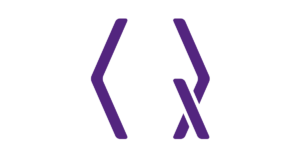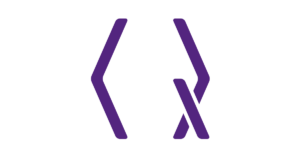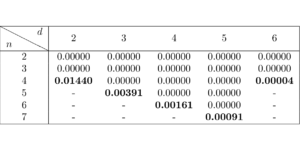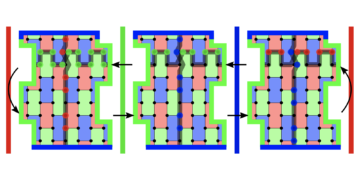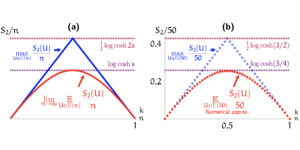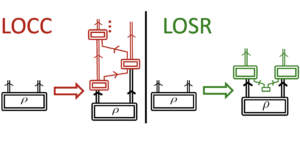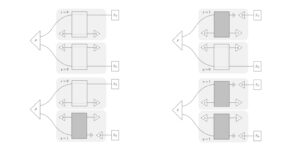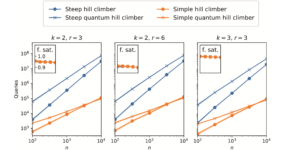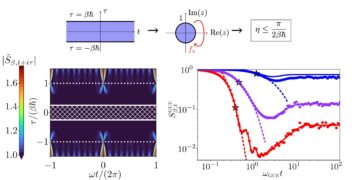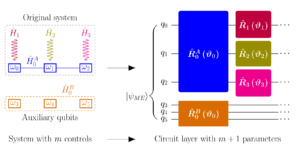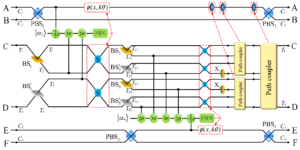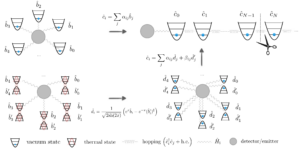1Quantum Research Center, Technology Innovation Institute, Abu Dhabi, UAE.
2Dipartimento di Fisica, Università di Milano-Bicocca, I-20126 Milano, Italy.
3INFN – Sezione di Milano Bicocca, I-20126 Milano, Italy.
4Departament de Física Quàntica i Astrofísica és Institut de Ciències del Cosmos (ICCUB), Universitat de Barcelona, Barcelona, Spanyolország.
5TIF Lab, Dipartimento di Fisica, Università degli Studi di Milano, Italy
6INFN, Sezione di Milano, I-20133 Milan, Italy.
7Istituto Nazionale di Fisica Nucleare (INFN), Sezione di Roma, Rome, Italy
8La Sapienza University of Rome, dep. of Physics, Rome, Italy
9CERN, Elméleti Fizikai Tanszék, CH-1211 Genf 23, Svájc.
10Division of Physics and Applied Physics, School of Physical and Mathematical Sciences, Nanyang Technological University, 21 Nanyang Link, Singapore 637371, Singapore.
11Centre for Quantum Technologies, National University of Singapore, Singapore.
Érdekesnek találja ezt a cikket, vagy szeretne megvitatni? Scite vagy hagyjon megjegyzést a SciRate-en.
Absztrakt
We present $texttt{Qibolab}$, an open-source software library for quantum hardware control integrated with the $texttt{Qibo}$ quantum computing middleware framework. $texttt{Qibolab}$ provides the software layer required to automatically execute circuit-based algorithms on custom self-hosted quantum hardware platforms. We introduce a set of objects designed to provide programmatic access to quantum control through pulses-oriented drivers for instruments, transpilers and optimization algorithms. $texttt{Qibolab}$ enables experimentalists and developers to delegate all complex aspects of hardware implementation to the library so they can standardize the deployment of quantum computing algorithms in a extensible hardware-agnostic way, using superconducting qubits as the first officially supported quantum technology. We first describe the status of all components of the library, then we show examples of control setup for superconducting qubits platforms. Finally, we present successful application results related to circuit-based algorithms.
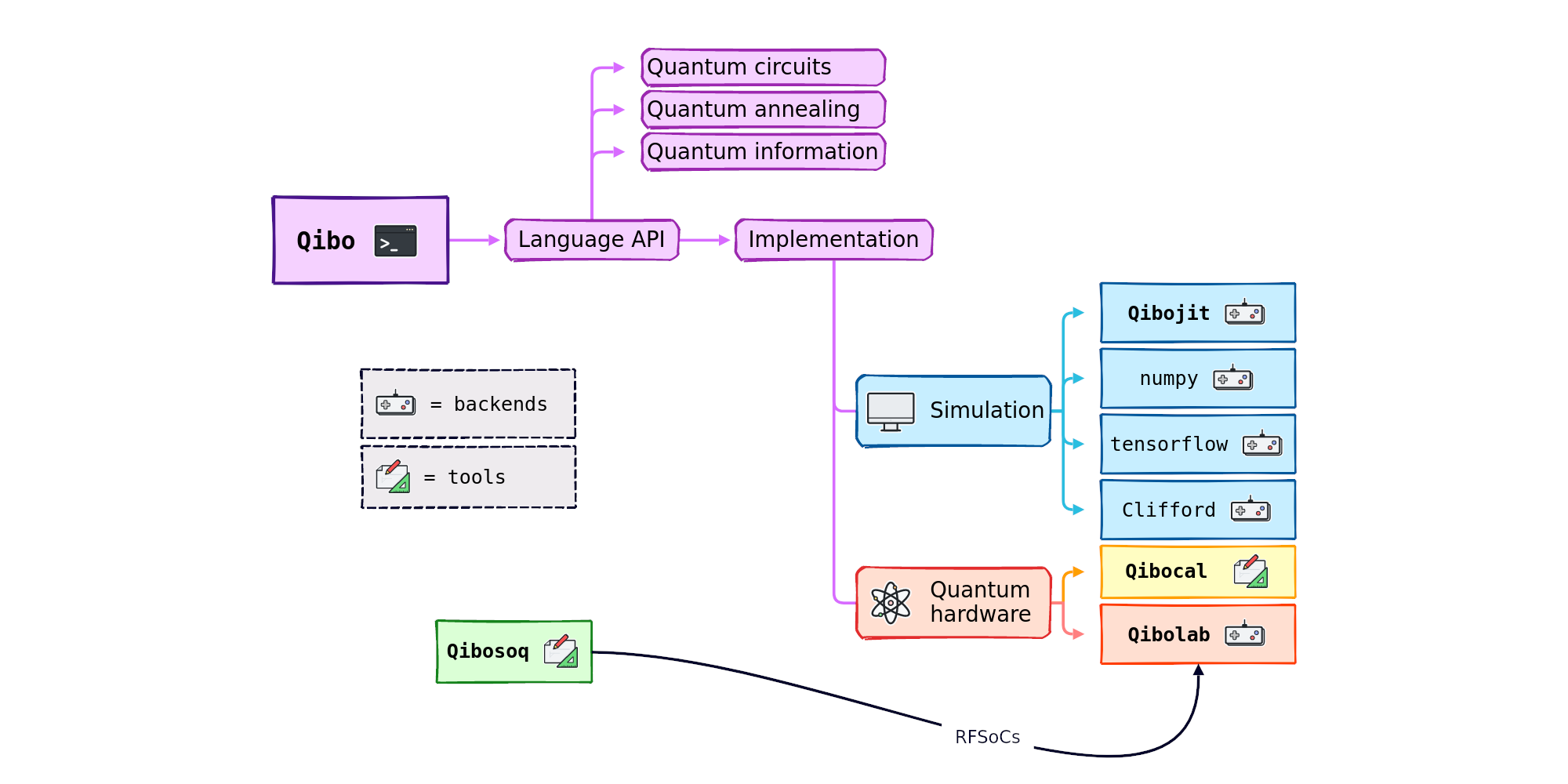
Featured image: Qibo software ecosystem.
Népszerű összefoglaló
► BibTeX adatok
► Referenciák
[1] R. Brun and F. Rademakers, Nuclear Instruments and Methods in Physics Research Section A: Accelerators, Spectrometers, Detectors and Associated Equipment 389, 81 (1997), new Computing Techniques in Physics Research V.
https://doi.org/10.1016/S0168-9002(97)00048-X
[2] J. Alwall, R. Frederix, S. Frixione, V. Hirschi, F. Maltoni, O. Mattelaer, H.-S. Shao, T. Stelzer, P. Torrielli, and M. Zaro, Journal of High Energy Physics 2014, 10.1007/jhep07(2014)079 (2014).
https:///doi.org/10.1007/jhep07(2014)079
[3] M. Abadi, A. Agarwal, P. Barham, E. Brevdo, Z. Chen, C. Citro, GS Corrado, A. Davis, J. Dean, M. Devin, S. Ghemawat, I. Goodfellow, A. Harp , G. Irving, M. Isard, Y. Jia, R. Jozefowicz, L. Kaiser, M. Kudlur, J. Levenberg, D. Mané, R. Monga, S. Moore, D. Murray, C. Olah, M Schuster, J. Shlens, B. Steiner, I. Sutskever, K. Talwar, P. Tucker, V. Vanhoucke, V. Vasudevan, F. Viégas, O. Vinyals, P. Warden, M. Wattenberg, M. Wicke , Y. Yu és X. Zheng, TensorFlow: Large-scale machine learning on heterogeneus systems (2015), szoftver elérhető a tensorflow.org webhelyről.
https:///www.tensorflow.org/
[4] Cirq, a python framework for creating, editing, and invoking Noisy Intermediate Scale Quantum (NISQ) circuits (2018).
https:///github.com/quantumlib/Cirq
[5] M. Broughton and et al., Tensorflow quantum: A software framework for quantum machine learning (2020).
https:///doi.org/10.48550/arXiv.2003.02989
[6] H. Abraham and et al., Qiskit: An open-source framework for quantum computing (2019).
https:///doi.org/10.5281/zenodo.2562110
[7] R. S. Smith, M. J. Curtis, and W. J. Zeng, A practical quantum instruction set architecture (2016).
https:///doi.org/10.48550/arXiv.1608.03355
[8] G. G. Guerreschi, J. Hogaboam, F. Baruffa, and N. P. D. Sawaya, Quantum Science and Technology 5, pp. 034007 (2020).
https:///doi.org/10.1088/2058-9565/ab8505
[9] A. Kelly, Simulating quantum computers using opencl (2018).
https:///doi.org/10.48550/arXiv.1805.00988
[10] The Qulacs developers, Qulacs (2018).
https:///github.com/qulacs/qulacs
[11] T. Jones, A. Brown, I. Bush, and S. C. Benjamin, Scientific Reports 9, 10.1038/s41598-019-47174-9 (2019).
https://doi.org/10.1038/s41598-019-47174-9
[12] P. Zhang, J. Yuan, and X. Lu, in Algorithms and Architectures for Parallel Processing, edited by G. Wang, A. Zomaya, G. Martinez, and K. Li (Springer International Publishing, Cham, 2015) pp. 241–256.
https://doi.org/10.1007/978-3-319-27119-4_17
[13] DS Steiger, T. Häner és M. Troyer, Quantum 2, 49 (2018).
https://doi.org/10.22331/q-2018-01-31-49
[14] The Q# programming language (2017).
https://docs.microsoft.com/en-us/quantum/user-guide/?view=qsharp-preview
[15] A. Zulehner and R. Wille, Advanced simulation of quantum computations (2017).
https:///doi.org/10.48550/arXiv.1707.00865
[16] E. Pednault and et al., Pareto-efficient quantum circuit simulation using tensor contraction deferral (2017).
https:///doi.org/10.48550/arXiv.1710.05867
[17] S. Bravyi and D. Gosset, Physical Review Letters 116, pp. 250501 (2016).
https:///doi.org/10.1103/PhysRevLett.116.250501
[18] K. De Raedt and et al., Computer Physics Communications 176, pp. 121 (2007).
https:///doi.org/10.1016/j.cpc.2006.08.007
[19] E. S. Fried and et al., PLOS ONE 13, e0208510 (2018).
https:///doi.org/10.1371/journal.pone.0208510
[20] B. Villalonga and et al., npj Quantum Information 5, 10.1038/s41534-019-0196-1 (2019).
https://doi.org/10.1038/s41534-019-0196-1
[21] X.-Z. Luo, J.-G. Liu, P. Zhang, and L. Wang, Yao.jl: Extensible, efficient framework for quantum algorithm design (2019), [quant-ph].
https://doi.org/10.22331/q-2020-10-11-341
[22] V. Bergholm and et al., Pennylane: Automatic differentiation of hybrid quantum-classical computations (2018), arXiv:1811.04968 [quant-ph].
arXiv: 1811.04968
[23] J. Doi and et al., in Proceedings of the 16th ACM International Conference on Computing Frontiers, CF ’19 (Association for Computing Machinery, New York, NY, USA, 2019) p. 85–93.
https:///doi.org/10.1145/3310273.3323053
[24] M. Möller and M. Schalkers, in Computational Science – ICCS 2020, edited by V. V. Krzhizhanovskaya, G. Závodszky, M. H. Lees, J. J. Dongarra, P. M. A. Sloot, S. Brissos, and J. Teixeira (Springer International Publishing, Cham, 2020) pp. 451–464.
https://doi.org/10.1007/978-3-030-50433-5_35
[25] T. Jones and S. Benjamin, Quantum Science and Technology 5, 034012 (2020).
https:///doi.org/10.1088/2058-9565/ab8506
[26] Z.-Y. Chen and et al., Science Bulletin 63, pp. 964–971 (2018).
https:///doi.org/10.1016/j.scib.2018.06.007
[27] H. Bian, J. Huang, R. Dong, Y. Guo, and X. Wang, in Algorithms and Architectures for Parallel Processing, edited by M. Qiu (Springer International Publishing, 2020) pp. 111–125.
https://doi.org/10.1007/978-3-030-60239-0_8
[28] I. Meyerov, A. Liniov, M. Ivanchenko, and S. Denisov, Simulating quantum dynamics: Evolution of algorithms in the hpc context (2020), arXiv:2005.04681 [quant-ph].
arXiv: 2005.04681
[29] A. A. Moueddene, N. Khammassi, K. Bertels, and C. G. Almudever, Realistic simulation of quantum computation using unitary and measurement channels (2020),.
https:///doi.org/10.1103/PhysRevA.102.052608
[30] Z. Wang and et al., A quantum circuit simulator and its applications on sunway taihulight supercomputer (2020).
https:///doi.org/10.1038/s41598-020-79777-y
[31] J. H. Nielsen, M. Astafev, W. H. Nielsen, D. Vogel, lakhotiaharshit, A. Johnson, A. Hardal, Akshita, sohail chatoor, F. Bonabi, Liang, G. Ungaretti, S. Pauka, T. Morgan, Adriaan, P. Eendebak, B. Nijholt, qSaevar, P. Eendebak, S. Droege, Samantha, J. Darulova, R. van Gulik, N. Pearson, ThorvaldLarsen, and A. Corna, Qcodes/qcodes: Qcodes 0.43.0 (2024).
https:///doi.org/10.5281/zenodo.10459033
[32] M. Rol, C. Dickel, S.Asaad, N. Langford, C. Bultink, R. Sagastizabal, N. Langford, G. de Lange, X. Fu, S. de Jong, F. Luthi, and W. Vlothuizen, DiCarloLab-Delft/PycQED_py3: Initial public release (2016).
https:///doi.org/10.5281/zenodo.160327
[33] Keysight, Labber, https://www.keysight.com/us/en/lib/software-detail/instrument-firmware-software/labber-3113052.html (2022).
https://www.keysight.com/us/en/lib/software-detail/instrument-firmware-software/labber-3113052.html
[34] S. Efthymiou, S. Ramos-Calderer, C. Bravo-Prieto, A. Pérez-Salinas, a.-M. . í, . Diego Garcí, A. Garcia-Saez, J. I. Latorre, and S. Carrazza, Quantum Science and Technology 7, 015018 (2021).
https://doi.org/10.1088/2058-9565/ac39f5
[35] S. Efthymiou, M. Lazzarin, A. Pasquale, and S. Carrazza, Quantum 6, 814 (2022).
https://doi.org/10.22331/q-2022-09-22-814
[36] S. Carrazza, S. Efthymiou, M. Lazzarin, and A. Pasquale, Journal of Physics: Conference Series 2438, 012148 (2023).
https://doi.org/10.1088/1742-6596/2438/1/012148
[37] S. Efthymiou et al., qiboteam/qibo: Qibo 0.1.12 (2023a).
https:///doi.org/10.5281/zenodo.7736837
[38] S. Efthymiou et al., qiboteam/qibolab: Qibolab 0.0.2 (2023b).
https:///doi.org/10.5281/zenodo.7748527
[39] J. Preskill, (2018a).
http://theory.caltech.edu/~preskill/ph219/chap3_15.pdf
[40] A. He, B. Nachman, W. A. de Jong, and C. W. Bauer, Phys. Rev. A 102, 012426 (2020).
https:///doi.org/10.1103/PhysRevA.102.012426
[41] A. Sopena, M. H. Gordon, G. Sierra, and E. López, Quantum Science and Technology 6, 045003 (2021).
https://doi.org/10.1088/2058-9565/ac0e7a
[42] E. van den Berg, Z. K. Minev, and K. Temme, Physical Review A 105, 10.1103/physreva.105.032620 (2022).
https:///doi.org/10.1103/physreva.105.032620
[43] D. Coppersmith, An approximate fourier transform useful in quantum factoring (2002a).
https:///doi.org/10.48550/arXiv.quant-ph/0201067
arXiv:quant-ph/0201067
[44] A. Peruzzo and et al., Nature communications 5, pp. 4213 (2014).
https:///doi.org/10.1038/ncomms5213
[45] A. Garcia-Saez and J. I. Latorre, Addressing hard classical problems with adiabatically assisted variational quantum eigensolvers (2018).
https:///doi.org/10.48550/arXiv.1806.02287
[46] E. Farhi, J. Goldstone, and S. Gutmann, A quantum approximate optimization algorithm (2014).
https:///doi.org/10.48550/arXiv.1411.4028
[47] A. B. Magann, K. M. Rudinger, M. D. Grace, and M. Sarovar, Physical Review Letters 129, 10.1103/physrevlett.129.250502 (2022).
https:///doi.org/10.1103/physrevlett.129.250502
[48] C. Bravo-Prieto, J. Baglio, M. Cè, A. Francis, D. M. Grabowska, and S. Carrazza, Quantum 6, 777 (2022).
https://doi.org/10.22331/q-2022-08-17-777
[49] L. K. Grover, A fast quantum mechanical algorithm for database search (1996).
https:///doi.org/10.48550/arXiv.quant-ph/9605043
arXiv:quant-ph/9605043
[50] S. Hadfield, Z. Wang, B. O. Gorman, E. Rieffel, D. Venturelli, and R. Biswas, Algorithms 12, 34 (2019).
https:///doi.org/10.3390/a12020034
[51] E. Farhi, J. Goldstone, S. Gutmann, and M. Sipser, Quantum computation by adiabatic evolution (2000).
https:///doi.org/10.48550/arXiv.quant-ph/0001106
arXiv:quant-ph/0001106
[52] Qibo: API documentation examples, https://qibo.science/qibo/stable/api-reference/index.html.
https://qibo.science/qibo/stable/api-reference/index.html
[53] J. Preskill, Quantum 2, 79 (2018b).
https://doi.org/10.22331/q-2018-08-06-79
[54] T. E. Oliphant, Guide to NumPy (Trelgol, 2006).
[55] D. E. Rumelhart, G. E. Hinton, and R. J. Williams, Nature 323, 533 (1986).
https:///doi.org/10.1038/323533a0
[56] SK Lam, A. Pitrou és S. Seibert, Proceedings of the Second Workshop on the LLVM Compiler Infrastructure in HPC (2015) 1–6.
https:///doi.org/10.1145/2833157.2833162
[57] R. Okuta, Y. Unno, D. Nishino, S. Hido és C. Loomis, Proceedings of Workshop on Machine Learning Systems (LearningSys) a The Thirty-First Annual Conference on Neural Information Processing Systems (NIPS) című kiadványban (2017) .
http:///learningsys.org/nips17/assets/papers/paper_16.pdf
[58] T. cuQuantum development team, cuquantum (2023), if you use this software, please cite it as below.
https:///doi.org/10.5281/zenodo.7806810
[59] D. Coppersmith, An approximate fourier transform useful in quantum factoring (2002b).
https:///doi.org/10.48550/arXiv.quant-ph/0201067
arXiv:quant-ph/0201067
[60] E. Bernstein and U. Vazirani, SIAM Journal on Computing 26, 1411 (1997).
https:///doi.org/10.1137/S0097539796300921
[61] J. Biamonte and V. Bergholm, Tensor networks in a nutshell (2017).
https:///doi.org/10.48550/arXiv.1708.00006
[62] X. Yuan, J. Sun, J. Liu, Q. Zhao, and Y. Zhou, Physical Review Letters 127, 10.1103/physrevlett.127.040501 (2021).
https:///doi.org/10.1103/physrevlett.127.040501
[63] W. Huggins, P. Patil, B. Mitchell, K. B. Whaley, and E. M. Stoudenmire, Quantum Science and Technology 4, 024001 (2019).
https:///doi.org/10.1088/2058-9565/aaea94
[64] R. Orús, Annals of Physics 349, 117 (2014).
https:///doi.org/10.1016/j.aop.2014.06.013
[65] J. Biamonte, Lectures on quantum tensor networks (2020).
https:///doi.org/10.48550/arXiv.1912.10049
[66] F. Arute, K. Arya, R. Babbush, D. Bacon, J. Bardin, R. Barends, R. Biswas, S. Boixo, F. Brandao, D. Buell, B. Burkett, Y. Chen, J. Chen, B. Chiaro, R. Collins, W. Courtney, A. Dunsworth, E. Farhi, B. Foxen, A. Fowler, C. M. Gidney, M. Giustina, R. Graff, K. Guerin, S. Habegger, M. Harrigan, M. Hartmann, A. Ho, M. R. Hoffmann, T. Huang, T. Humble, S. Isakov, E. Jeffrey, Z. Jiang, D. Kafri, K. Kechedzhi, J. Kelly, P. Klimov, S. Knysh, A. Korotkov, F. Kostritsa, D. Landhuis, M. Lindmark, E. Lucero, D. Lyakh, S. Mandrà, J. R. McClean, M. McEwen, A. Megrant, X. Mi, K. Michielsen, M. Mohseni, J. Mutus, O. Naaman, M. Neeley, C. Neill, M. Y. Niu, E. Ostby, A. Petukhov, J. Platt, C. Quintana, E. G. Rieffel, P. Roushan, N. Rubin, D. Sank, K. J. Satzinger, V. Smelyanskiy, K. J. Sung, M. Trevithick, A. Vainsencher, B. Villalonga, T. White, Z. J. Yao, P. Yeh, A. Zalcman, H. Neven, and J. Martinis, Nature 574, 505–510 (2019).
https://doi.org/10.1038/s41586-019-1666-5
[67] Y. Y. Gao, M. A. Rol, S. Touzard, and C. Wang, PRX Quantum 2, 040202 (2021).
https:///doi.org/10.1103/PRXQuantum.2.040202
[68] D. Leibfried, R. Blatt, C. Monroe és D. Wineland, Rev. Mod. Phys. 75, 281 (2003).
https:///doi.org/10.1103/RevModPhys.75.281
[69] L. Henriet, L. Beguin, A. Signoles, T. Lahaye, A. Browaeys, G.-O. Reymond, and C. Jurczak, Quantum 4, 327 (2020).
https://doi.org/10.22331/q-2020-09-21-327
[70] J. Koch, T. M. Yu, J. Gambetta, A. A. Houck, D. I. Schuster, J. Majer, A. Blais, M. H. Devoret, S. M. Girvin, and R. J. Schoelkopf, Physical Review A 76, 10.1103/physreva.76.042319 (2007).
https:///doi.org/10.1103/physreva.76.042319
[71] B. D. Josephson, Phys. Lett. 1, 251 (1962).
https://doi.org/10.1016/0031-9163(62)91369-0
[72] T. Alexander, N. Kanazawa, D. J. Egger, L. Capelluto, C. J. Wood, A. Javadi-Abhari, and D. C McKay, Quantum Science and Technology 5, 044006 (2020).
https:///doi.org/10.1088/2058-9565/aba404
[73] H. Silvério, S. Grijalva, C. Dalyac, L. Leclerc, P. J. Karalekas, N. Shammah, M. Beji, L.-P. Henry, and L. Henriet, Quantum 6, 629 (2022).
https://doi.org/10.22331/q-2022-01-24-629
[74] ZurichInstruments, https://www.zhinst.com/others/en/quantum-computing-systems/labone-q (2023a).
https://www.zhinst.com/others/en/quantum-computing-systems/labone-q
[75] L. Ella, L. Leandro, O. Wertheim, Y. Romach, R. Szmuk, Y. Knol, N. Ofek, I. Sivan, and Y. Cohen, Quantum-classical processing and benchmarking at the pulse-level (2023).
https:///doi.org/10.48550/arXiv.2303.03816
[76] Qblox, https://qblox-qblox-instruments.readthedocs-hosted.com/en/master/ (2023a).
https://qblox-qblox-instruments.readthedocs-hosted.com/en/master/
[77] M. Naghiloo, Introduction to experimental quantum measurement with superconducting qubits (2019).
https:///doi.org/10.48550/arXiv.1904.09291
[78] A. Pasquale et al., qiboteam/qibocal: Qibocal 0.0.1 (2023a).
https:///doi.org/10.5281/zenodo.7662185
[79] A. Pasquale, S. Efthymiou, S. Ramos-Calderer, J. Wilkens, I. Roth, and S. Carrazza, Towards an open-source framework to perform quantum calibration and characterization (2023b).
https:///doi.org/10.48550/arXiv.2303.10397
[80] M. Kliesch and I. Roth, PRX Quantum 2, 010201 (2021).
https:///doi.org/10.1103/PRXQuantum.2.010201
[81] J. Emerson, R. Alicki, and K. Zyczkowski, J. Opt. B 7, S347 (2005).
https://doi.org/10.1088/1464-4266/7/10/021
[82] E. Knill, D. Leibfried, R. Reichle, J. Britton, R. B. Blakestad, J. D. Jost, C. Langer, R. Ozeri, S. Seidelin, and D. J. Wineland, Physical Review A 77, 10.1103/physreva.77.012307 (2008).
https:///doi.org/10.1103/physreva.77.012307
[83] B. Lévi, C. C. López, J. Emerson, and D. G. Cory, Phys. Rev. A 75, 022314 (2007).
https:///doi.org/10.1103/PhysRevA.75.022314
[84] C. Dankert, R. Cleve, J. Emerson, and E. Livine, Phys. Rev. A 80, 012304 (2009).
https:///doi.org/10.1103/PhysRevA.80.012304
[85] J. Helsen, I. Roth, E. Onorati, A. H. Werner, and J. Eisert, arXiv:2010.07974 3, 020357 (2022).
https:///doi.org/10.1103/PRXQuantum.3.020357
arXiv: 2010.07974
[86] A. P. et al, In preparation (2023).
[87] F. Motzoi, J. M. Gambetta, P. Rebentrost, and F. K. Wilhelm, Phys. Rev. Lett. 103, 110501 (2009).
https:///doi.org/10.1103/PhysRevLett.103.110501
[88] J. Heinsoo, C. K. Andersen, A. Remm, S. Krinner, T. Walter, Y. Salathé, S. Gasparinetti, J.-C. Besse, A. Poto čnik, A. Wallraff, and C. Eichler, Phys. Rev. Appl. 10, 034040 (2018).
https:///doi.org/10.1103/PhysRevApplied.10.034040
[89] Y. Xu, G. Huang, J. Balewski, A. Morvan, K. Nowrouzi, D. I. Santiago, R. K. Naik, B. Mitchell, and I. Siddiqi, ACM Transactions on Quantum Computing 4, 10.1145/3529397 (2022).
https:///doi.org/10.1145/3529397
[90] J. Kelly, P. O’Malley, M. Neeley, H. Neven, and J. M. Martinis, Physical qubit calibration on a directed acyclic graph (2018).
https:///doi.org/10.48550/arXiv.1803.03226
[91] Qibolab: Platform creation, https://qibo.science/qibolab/stable/tutorials/lab.html.
https://qibo.science/qibolab/stable/tutorials/lab.html
[92] Qibolab: Platform serialization, https://qibo.science/qibolab/stable/api-reference/qibolab.html#module-qibolab.serialize.
https://qibo.science/qibolab/stable/api-reference/qibolab.html#module-qibolab.serialize
[93] Qibolab: Result formats, https://qibo.science/qibolab/stable/main-documentation/qibolab.html#results.
https://qibo.science/qibolab/stable/main-documentation/qibolab.html#results
[94] Qblox, https://www.qblox.com.
https://www.qblox.com
[95] QuantumMachines, https://www.quantum-machines.co/.
https://www.quantum-machines.co/
[96] ZurichInstruments, https://www.zhinst.com/others/en/quantum-computing-systems/qccs (2023b).
https://www.zhinst.com/others/en/quantum-computing-systems/qccs
[97] L. Stefanazzi, K. Treptow, N. Wilcer, C. Stoughton, C. Bradford, S. Uemura, S. Zorzetti, S. Montella, G. Cancelo, S. Sussman, A. Houck, S. Saxena, H. Arnaldi, A. Agrawal, H. Zhang, C. Ding, and D. I. Schuster, Review of Scientific Instruments 93, 10.1063/5.0076249 (2022).
https:///doi.org/10.1063/5.0076249
[98] R. Carobene et al., qiboteam/qibosoq: Qibosoq 0.0.3 (2023).
https:///doi.org/10.5281/zenodo.8126172
[99] Qblox, https://qblox-qblox-instruments.readthedocs-hosted.com/en/master/getting_started/product_overview.html#cluster.
https://qblox-qblox-instruments.readthedocs-hosted.com/en/master/getting_started/product_overview.html#cluster
[100] Qblox, https://qblox-qblox-instruments.readthedocs-hosted.com/en/master/cluster/qrm_rf.html (2023b).
https://qblox-qblox-instruments.readthedocs-hosted.com/en/master/cluster/qrm_rf.html
[101] Qblox, https://qblox-qblox-instruments.readthedocs-hosted.com/en/master/cluster/qcm_rf.html (2023c).
https://qblox-qblox-instruments.readthedocs-hosted.com/en/master/cluster/qcm_rf.html
[102] Qblox, https://qblox-qblox-instruments.readthedocs-hosted.com/en/master/cluster/qcm.html (2023d).
https://qblox-qblox-instruments.readthedocs-hosted.com/en/master/cluster/qcm.html
[103] Qblox, https://qblox-qblox-instruments.readthedocs-hosted.com/en/master/cluster/synchronization.html#synq.
https://qblox-qblox-instruments.readthedocs-hosted.com/en/master/cluster/synchronization.html#synq
[104] Qcodes, https://qcodes.github.io/Qcodes/ (2023).
https://qcodes.github.io/Qcodes/
[105] Qblox, https://qblox-qblox-instruments.readthedocs-hosted.com/en/master/tutorials/q1asm_tutorials.html (2023e).
https://qblox-qblox-instruments.readthedocs-hosted.com/en/master/tutorials/q1asm_tutorials.html
[106] OPX+, https://www.quantum-machines.co/products/opx/.
https://www.quantum-machines.co/products/opx/
[107] ZurichInstruments, https://www.zhinst.com/others/en/products/shfqc-qubit-controller (2023c).
https://www.zhinst.com/others/en/products/shfqc-qubit-controller
[108] J. Herrmann, C. Hellings, S. Lazar, F. Pfäffli, F. Haupt, T. Thiele, D. C. Zanuz, G. J. Norris, F. Heer, C. Eichler, and A. Wallraff, Frequency up-conversion schemes for controlling superconducting qubits (2022).
https:///doi.org/10.48550/arXiv.2210.02513
[109] ZurichInstruments, https://www.zhinst.com/others/en/products/hdawg-arbitrary-waveform-generator (2023d).
https://www.zhinst.com/others/en/products/hdawg-arbitrary-waveform-generator
[110] ZurichInstruments, https://www.zhinst.com/others/en/products/pqsc-programmable-quantum-system-controller (2023e).
https://www.zhinst.com/others/en/products/pqsc-programmable-quantum-system-controller
[111] Xilinx-(AMD), Rfsoc 4×2 specifications, https://www.xilinx.com/support/university/xup-boards/RFSoC4x2.html (2022a).
https://www.xilinx.com/support/university/xup-boards/RFSoC4x2.html
[112] Xilinx-(AMD), Zcu111 specifications, https://www.xilinx.com/products/boards-and-kits/zcu111.html (2022b).
https://www.xilinx.com/products/boards-and-kits/zcu111.html
[113] Xilinx-(AMD), Zcu216 specifications, https://www.xilinx.com/products/boards-and-kits/zcu216.html (2022c).
https://www.xilinx.com/products/boards-and-kits/zcu216.html
[114] P. S. V. Naidu, Modern Digital Signal Processing (Alpha Science International, 2003).
[115] A. Barenco, C. H. Bennett, R. Cleve, D. P. DiVincenzo, N. Margolus, P. Shor, T. Sleator, J. A. Smolin, and H. Weinfurter, Physical Review A 52, 3457 (1995).
https:///doi.org/10.1103/physreva.52.3457
[116] T. Ito, N. Kakimura, N. Kamiyama, Y. Kobayashi, and Y. Okamoto, Algorithmic theory of qubit routing (2023).
https:///doi.org/10.48550/arXiv.2305.02059
[117] S. Heng, D. Kim, S. Heng, and Y. Han, in 2022 37th International Technical Conference on Circuits/Systems, Computers and Communications (ITC-CSCC) (2022) pp. 1–3.
https://doi.org/10.1109/ITC-CSCC55581.2022.9894863
[118] P. Zhu, S. Zheng, L. Wei, C. Xueyun, Z. Guan, and S. Feng, Quantum Information Processing 21 (2022).
https://doi.org/10.1007/s11128-022-03698-0
[119] T. Itoko, R. Raymond, T. Imamichi, and A. Matsuo, Optimization of quantum circuit mapping using gate transformation and commutation (2019).
https:///doi.org/10.48550/arXiv.1907.02686
[120] G. Vidal and C. M. Dawson, Physical Review A 69, 10.1103/physreva.69.010301 (2004).
https:///doi.org/10.1103/physreva.69.010301
[121] T. Fösel, M. Y. Niu, F. Marquardt, and L. Li, Quantum circuit optimization with deep reinforcement learning (2021).
https:///doi.org/10.48550/arXiv.2103.07585
[122] G. Li, Y. Ding, and Y. Xie, Tackling the qubit mapping problem for nisq-era quantum devices (2019).
https:///doi.org/10.48550/arXiv.1809.02573
[123] Y. Kharkov, A. Ivanova, E. Mikhantiev, and A. Kotelnikov, Arline benchmarks: Automated benchmarking platform for quantum compilers (2022).
https:///doi.org/10.48550/arXiv.2202.14025
[124] Qibolab benchmarks, https://github.com/qiboteam/qibolab-benchmarks/tree/v0.1.0.
https://github.com/qiboteam/qibolab-benchmarks/tree/v0.1.0
[125] JF Clauser, MA Horne, A. Shimony és RA Holt, Phys. Rev. Lett. 23, 880 (1969)].
https:///doi.org/10.1103/PhysRevLett.23.880
[126] JS Bell, Physics Physique Fizika 1, 195 (1964).
https:///doi.org/10.1103/PhysicsPhysiqueFizika.1.195
[127] M. Schuld, I. Sinayskiy, and F. Petruccione, Contemporary Physics 56, 172 (2014).
https:///doi.org/10.1080/00107514.2014.964942
[128] J. Biamonte, P. Wittek, N. Pancotti, P. Rebentrost, N. Wiebe és S. Lloyd, Nature 549, 195 (2017).
https:///doi.org/10.1038/nature23474
[129] K. Mitarai, M. Negoro, M. Kitagawa, and K. Fujii, Physical Review A 98, 10.1103/physreva.98.032309 (2018).
https:///doi.org/10.1103/physreva.98.032309
[130] M. Cerezo, A. Arrasmith, R. Babbush, S. C. Benjamin, S. Endo, K. Fujii, J. R. McClean, K. Mitarai, X. Yuan, L. Cincio és P. J. Coles, Nature Reviews Physics 3, 625 (2021) ).
https://doi.org/10.1038/s42254-021-00348-9
[131] S. Wang, E. Fontana, M. Cerezo, K. Sharma, A. Sone, L. Cincio, and P. J. Coles, Nature Communications 12, 10.1038/s41467-021-27045-6 (2021).
https://doi.org/10.1038/s41467-021-27045-6
[132] A. Pérez-Salinas, J. Cruz-Martinez, A. A. Alhajri, and S. Carrazza, Physical Review D 103, 10.1103/physrevd.103.034027 (2021).
https:///doi.org/10.1103/physrevd.103.034027
[133] M. Robbiati, J. M. Cruz-Martinez, and S. Carrazza, Determining probability density functions with adiabatic quantum computing (2023).
https:///doi.org/10.48550/arXiv.2303.11346
[134] S. Bordoni, D. Stanev, T. Santantonio, and S. Giagu, Particles 6, 297 (2023).
https://doi.org/10.3390/particles6010016
[135] M. Robbiati, S. Efthymiou, A. Pasquale, and S. Carrazza, A quantum analytical adam descent through parameter shift rule using qibo (2022).
https:///doi.org/10.48550/arXiv.2210.10787
[136] R. D. Ball, S. Carrazza, J. Cruz-Martinez, L. D. Debbio, S. Forte, T. Giani, S. Iranipour, Z. Kassabov, J. I. Latorre, E. R. Nocera, R. L. Pearson, J. Rojo, R. Stegeman, C. Schwan, M. Ubiali, C. Voisey, and M. Wilson, The European Physical Journal C 82, 10.1140/epjc/s10052-022-10328-7 (2022).
https://doi.org/10.1140/epjc/s10052-022-10328-7
[137] A. Pérez-Salinas, A. Cervera-Lierta, E. Gil-Fuster és J. I. Latorre, Quantum 4, 226 (2020).
https://doi.org/10.22331/q-2020-02-06-226
[138] D. P. Kingma and J. Ba, Adam: A method for stochastic optimization (2017).
https:///doi.org/10.48550/arXiv.1412.6980
[139] M. Schuld, V. Bergholm, C. Gogolin, J. Izaac, and N. Killoran, Physical Review A 99, 10.1103/physreva.99.032331 (2019).
https:///doi.org/10.1103/physreva.99.032331
Idézi
[1] Jorge J. Martínez de Lejarza, Leandro Cieri, Michele Grossi, Sofia Vallecorsa, and Germán Rodrigo, “Loop Feynman integration on a quantum computer”, arXiv: 2401.03023, (2024).
[2] Alessandro D’Elia, Boulos Alfakes, Anas Alkhazaleh, Leonardo Banchi, Matteo Beretta, Stefano Carrazza, Fabio Chiarello, Daniele Di Gioacchino, Andrea Giachero, Felix Henrich, Alex Stephane Piedjou Komnang, Carlo Ligi, Giovanni Maccarrone, Massimo Macucci, Emanuele Palumbo, Andrea Pasquale, Luca Piersanti, Florent Ravaux, Alessio Rettaroli, Matteo Robbiati, Simone Tocci, and Claudio Gatti, “Characterization of a Transmon Qubit in a 3D Cavity for Quantum Machine Learning and Photon Counting”, arXiv: 2402.04322, (2024).
[3] Chunyang Ding, Martin Di Federico, Michael Hatridge, Andrew Houck, Sebastien Leger, Jeronimo Martinez, Connie Miao, David I. Schuster, Leandro Stefanazzi, Chris Stoughton, Sara Sussman, Ken Treptow, Sho Uemura, Neal Wilcer, Helin Zhang, Chao Zhou, and Gustavo Cancelo, “Experimental advances with the QICK (Quantum Instrumentation Control Kit) for superconducting quantum hardware”, arXiv: 2311.17171, (2023).
[4] Steve Abel, Juan Carlos Criado, and Michael Spannowsky, “Training Neural Networks with Universal Adiabatic Quantum Computing”, arXiv: 2308.13028, (2023).
[5] Matteo Robbiati, Alejandro Sopena, Andrea Papaluca és Stefano Carrazza, „Valós idejű hibacsökkentés a kvantumhardver variációs optimalizálásához”, arXiv: 2311.05680, (2023).
[6] Edoardo Pedicillo, Andrea Pasquale, and Stefano Carrazza, “Benchmarking machine learning models for quantum state classification”, arXiv: 2309.07679, (2023).
A fenti idézetek innen származnak SAO/NASA HIRDETÉSEK (utolsó sikeres frissítés: 2024-02-16 14:18:42). Előfordulhat, hogy a lista hiányos, mivel nem minden kiadó ad megfelelő és teljes hivatkozási adatokat.
On Crossref által idézett szolgáltatás művekre hivatkozó adat nem található (utolsó próbálkozás 2024-02-16 14:18:40).
Ez a tanulmány a Quantumban jelent meg Creative Commons Nevezd meg 4.0 International (CC BY 4.0) engedély. A szerzői jog az eredeti szerzői jog tulajdonosainál marad, például a szerzőknél vagy intézményeiknél.
- SEO által támogatott tartalom és PR terjesztés. Erősödjön még ma.
- PlatoData.Network Vertical Generative Ai. Erősítse meg magát. Hozzáférés itt.
- PlatoAiStream. Web3 Intelligence. Felerősített tudás. Hozzáférés itt.
- PlatoESG. Carbon, CleanTech, Energia, Környezet, Nap, Hulladékgazdálkodás. Hozzáférés itt.
- PlatoHealth. Biotechnológiai és klinikai vizsgálatok intelligencia. Hozzáférés itt.
- Forrás: https://quantum-journal.org/papers/q-2024-02-12-1247/
- :is
- :nem
- ][p
- 06
- 08
- 1
- 10
- 100
- 11
- 114
- 116
- 118
- 12
- 120
- 121
- 125
- 13
- 130
- 135
- 14
- 15%
- 16
- 16th
- 17
- 19
- 195
- 1995
- 1996
- 20
- 2000
- 2005
- 2006
- 2008
- 2009
- 2014
- 2015
- 2016
- 2017
- 2018
- 2019
- 2020
- 2021
- 2022
- 2023
- 2024
- 22
- 23
- 24
- 25
- 26%
- 27
- 28
- 29
- 30
- 31
- 32
- 33
- 35%
- 36
- 39
- 3d
- 40
- 41
- 43
- 49
- 50
- 51
- 54
- 58
- 60
- 65
- 66
- 67
- 7
- 70
- 72
- 75
- 77
- 8
- 80
- 84
- 87
- 89
- 9
- 91
- 97
- 98
- a
- felett
- Ábrahám
- KIVONAT
- abu dhabi
- gyorsítók
- hozzáférés
- ACM
- aciklikus
- Ádám
- címzés
- fejlett
- előlegek
- hovatartozás
- AL
- alex
- Alexander
- algoritmus
- algoritmikus
- algoritmusok
- Minden termék
- Alpha
- AMD
- an
- Analitikai
- és a
- Andrew
- évi
- api
- Alkalmazás
- alkalmazások
- alkalmazott
- hozzávetőleges
- építészet
- architektúrák
- VANNAK
- arya
- AS
- szempontok
- munkáját
- társult
- Egyesület
- At
- kísérlet
- szerző
- szerzők
- Automatizált
- Automatikus
- automatikusan
- elérhető
- labda
- barcelona
- BE
- Csengő
- lent
- benchmarking
- referenciaértékek
- Benjámin
- Bernstein
- BIAN
- szünet
- barna
- hirdetőtábla
- by
- TUD
- carlos
- Központ
- Tanúsítvány
- csatornák
- chen
- chris
- besorolás
- Cohen
- COM
- megjegyzés
- köznép
- távközlés
- teljes
- bonyolult
- alkatrészek
- számítás
- számítási
- számítások
- számítógép
- számítógépek
- számítástechnika
- Konferencia
- kortárs
- kontextus
- összehúzódás
- ellenőrzés
- kontrolling
- copyright
- Világegyetem
- számolás
- létrehozása
- teremtés
- szokás
- dátum
- adatbázis
- David
- Davis
- de
- mély
- del
- DEP
- osztály
- bevetés
- leírni
- Design
- tervezett
- meghatározó
- fejlesztők
- Fejlesztés
- fejlesztői csapat
- Eszközök
- Dhabi
- Diego
- Megkülönböztetés
- digitális
- irányított
- megvitatni
- dokumentáció
- dong
- illesztőprogramok
- dinamika
- e
- E&T
- ökoszisztéma
- hatékony
- lehetővé teszi
- energia
- felszerelés
- hiba
- európai
- evolúció
- példák
- kivégez
- kísérleti
- faktoring
- GYORS
- Február
- Federico
- Végül
- vezetéknév
- A
- Erős
- talált
- Keretrendszer
- Francis
- Frekvencia
- ból ből
- Frontiers
- fu
- funkciók
- GAO
- kapu
- Genf
- GitHub
- Gordon
- kegyelem
- grafikon
- Grover
- útmutató
- Kemény
- hardver
- Harvard
- he
- Henrik
- Magas
- tartók
- hpc
- HTML
- http
- HTTPS
- huang
- szerény
- hibrid
- hibrid kvantum-klasszikus
- i
- if
- kép
- végrehajtás
- in
- információ
- Infrastruktúra
- kezdetben
- Innováció
- Intézet
- intézmények
- eszközök
- integrált
- integráció
- érdekes
- Nemzetközi
- bevezet
- Bevezetés
- IT
- Olaszország
- ITS
- JavaScript
- jeffrey
- JL
- Johnson
- jones
- folyóirat
- juan
- Kim
- Koch
- labor
- Elnáspángol
- nyelv
- nagyarányú
- keresztnév
- réteg
- tanulás
- Szabadság
- előadások
- Olvassa el
- Li
- könyvtár
- Engedély
- LINK
- Lista
- gép
- gépi tanulás
- gépezet
- térképészet
- Márton
- matematikai
- max-width
- Lehet..
- mcclean
- mérés
- mechanikai
- módszer
- mód
- Michael
- microsoft
- MILAN
- MILAN
- enyhítés
- modellek
- modern
- Hónap
- Morgan
- Murray
- nemzeti
- Természet
- hálózatok
- ideg-
- neurális hálózatok
- Új
- New York
- nem
- nukleáris
- számtalan
- dióhéj
- NY
- objektumok
- of
- Hivatalosan
- on
- ONE
- nyitva
- nyílt forráskódú
- Nyílt forráskódú szoftver
- üzemeltetési
- operációs rendszer
- optimalizálás
- or
- eredeti
- oldalak
- Papír
- Párhuzamos
- paraméter
- Paul
- Pearson
- Teljesít
- fizikai
- Fizika
- emelvény
- Platformok
- Plató
- Platón adatintelligencia
- PlatoData
- kérem
- Gyakorlati
- előkészítés
- be
- Probléma
- problémák
- Eljárás
- feldolgozás
- programadó
- Programozás
- ad
- biztosít
- nyilvános
- közzétett
- kiadó
- kiadók
- Kiadás
- Piton
- qiskit
- Kvantum
- Kvantum számítógép
- kvantum számítógépek
- kvantumszámítás
- kvantumszámítási algoritmusok
- kvantuminformáció
- kvantum gépi tanulás
- kvantummérés
- kvantum operációs rendszer
- kvantum szoftver
- kvantumtechnika
- qubit
- qubit
- R
- real-time
- valószerű
- referenciák
- összefüggő
- engedje
- maradványok
- Jelentések
- kötelező
- kutatás
- eredményez
- Eredmények
- Kritika
- Vélemények
- Róma
- routing
- Szabály
- s
- Skála
- rendszerek
- Iskola
- Tudomány
- Tudomány és technológia
- TUDOMÁNYOK
- tudományos
- Keresés
- Második
- Rész
- Series of
- készlet
- felépítés
- Sharma
- váltás
- shor
- előadás
- Sziám
- Jel
- tettetés
- szimulátor
- Szingapúr
- kovács
- So
- szoftver
- Szoftverfejlesztők
- Spanyolország
- specifikációk
- Állami
- Állapot
- Steve
- sikeres
- sikeresen
- ilyen
- megfelelő
- nap
- szuperszámítógép
- szupravezető
- Támogatott
- svájc
- szinkronizál.
- rendszer
- Systems
- szerelések
- csapat
- Műszaki
- technikák
- technikai
- Technologies
- Technológia
- Technológiai innováció
- tensorflow
- A
- azok
- akkor
- elméleti
- elmélet
- ők
- ezt
- Keresztül
- Cím
- nak nek
- felé
- Képzések
- Tranzakciók
- Átalakítás
- Átalakítás
- Egyesült Arab Emírségek
- alatt
- Egyetemes
- egyetemi
- frissítve
- URL
- USA
- használ
- hasznos
- segítségével
- kötet
- W
- wang
- akar
- volt
- Út..
- we
- fehér
- Williams
- Wilson
- val vel
- faipari
- művek
- műhely
- X
- év
- york
- te
- Yuan
- zephyrnet
- Zhao

